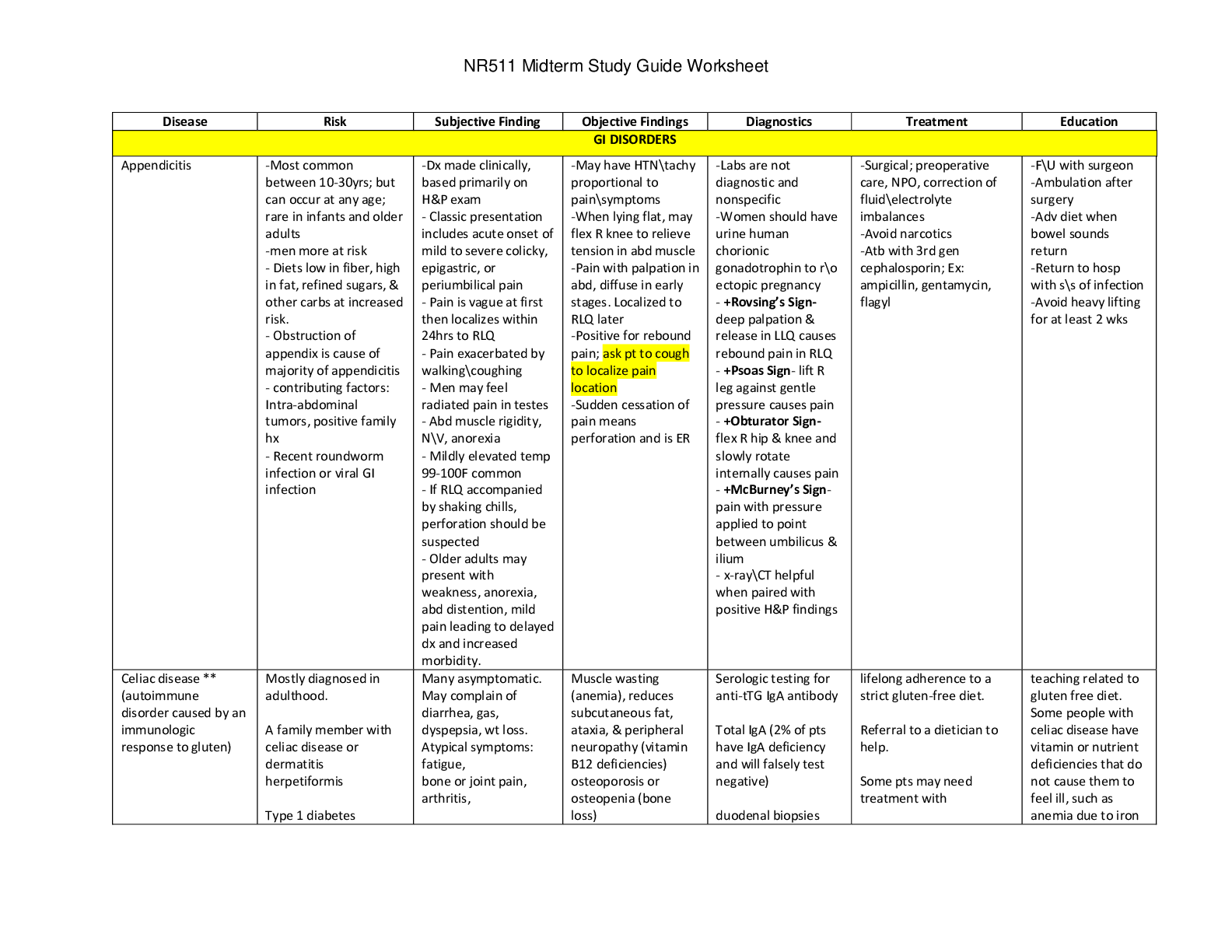Biology > QUESTIONS & ANSWERS > Biol 100 mastery exam 3 complete A+ guide (questions & answers_latest 2020 (All)
Biol 100 mastery exam 3 complete A+ guide (questions & answers_latest 2020
Document Content and Description Below
Bio mastery exam 3 QUESTION 1 Estimates derived from plot sampling are most accurate when species are not very ____ and conditions across their habitat are uniform. a. healthy b. well-define... d c. stationary d. mobile e. small in size 1 points QUESTION 2 Which characteristic applies to tropical rain forests? a. Diversity is limited because the tall forest canopy shuts out most of the incoming light. b. Competition for resources is extremely low. c. Temperatures vary greatly. d. Conditions are extremely favorable for growing luxuriant food crops. e. Little sunlight reaches the forest floor. 1 points QUESTION 3 Species richness in a community drastically declines after the removal of one species. This species was likely a(n) ____. a. mutualistic species b. pioneer species c. keystone species d. indicator species e. exotic species 1 points QUESTION 4 Many marine organisms incorporate carbon into their shells. After they die, these shells become part of the ____. a. ocean food web b. land food web c. atmosphere d. ocean e. sediment 1 points QUESTION 5 1. Figure 43.16 Seasonal changes in a temperate zone lake. In the accomnpanying figure, which letter(s) represent summer? a. A b. B c. C d. D e. A and C 1 points QUESTION 6 1. Which of these items of garbage have components that will last over 100 years? a. cardboard b. cigarette filter c. paper d. plastic bag e. disposable diaper 1 points QUESTION 7 1. What is the result when airborne sulfur and nitrogen oxides coat dust particles? a. a chemical reaction that produces sulfuric and nitric acids b. dry acid deposition and reduced soil pH when dust settles c. wet acid deposition and increased soil pH when dust settles d. dry acid deposition e. wet acid deposition 1 points QUESTION 8 1. Selecting the Exception Four of the five answers listed below are related by a similar area of the ocean. Select the exception. a. benthic province b. hydrothermic vents c. pelagic province d. continental shelves e. sea mounts 1 points QUESTION 9 1. The most recent mass extinction on Earth: a. happened 65 million years ago when dinosaurs became extinct b. happened 544 million years ago during a period of massive glaciation c. was 248 million years ago when Pangea formed d. is going on now and is due to human activities e. occurred 360 million years ago, when 70% of marine groups were lost 1 points QUESTION 10 1. Lichens take up nutrients and pollutants from airborne dust, so many cannot survive where the level of air pollution is high. The U.S. Forest Service monitors lichens on tree trunks as part of its program to assess the health of forest communities. Lichen is a(n) ____. a. keystone species b. indicator species c. pioneer species d. exotic species e. primary succession species 1 points QUESTION 11 1. A newly hatched cuckoo bird is blind, but contact with an object beside it stimulates it to push the object out of the nest. What term best describes this behavior? a. instinct b. time sensitive learning c. imprinting d. social landscape learning e. learned 1 points QUESTION 12 1. Heavy harvesting of which species during the 1970s reduced the population to about one percent of its original size?: a. Juga newberryi, a freshwater snail b. Capnia kersti, a stonefly c. Pyrgulopsis owyheensis, a springsnail d. Haliotis sorenseni, the white abalone e. Bombus occidentalis, the western bumblebee 1 points QUESTION 13 1. When one species actively prevents another from accessing a resource, it is called: a. interference competition b. exploitative competition c. scavenging d. interspecific competition e. predation 1 points QUESTION 14 1. Selecting the Exception Four of these five choices are global consequences of warmer temperatures. Select the exception. a. periods of drought b. more intense hurricanes c. periods of heavy precipitation d. rising sea levels e. some species shifting ranges to lower latitudes and elevations 1 points QUESTION 15 1. Selecting the Exception Four of these five choices are characteristics of sawfly caterpillars. Select the exception. a. prey of birds b. selfish herd c. vomit in self defense d. safety in numbers e. venomous 1 points QUESTION 16 1. Species richness is generally higher on larger islands because: a. more colonists from mainland areas will happen upon a larger island because of its size, bigger islands offer a wider variety of different habitats, and larger islands can support larger populations of species than smaller islands b. more colonists from mainland areas will happen upon a larger island because of its size and bigger islands offer a wider variety of different habitats only c. larger islands can support larger populations of species than smaller islands only d. bigger islands offer a wider variety of different habitats only e. more colonists from mainland areas will happen upon a larger island because of its size only 1 points QUESTION 17 1. Meeting the needs of the present generation without reducing the ability of future generations to meet their own needs is the goal of a. sociology b. biology c. conservation biology d. sustainability e. ecology 1 points QUESTION 18 1. A wind system that influences large climatic regions and reverses direction seasonally, producing dry and wet seasons, is referred to as a(n): a. monsoon b. upwelling c. hurricane d. taiga e. geothermal ecosystem 1 points QUESTION 19 1. The biome with the greatest range of daily temperature extremes is the: a. desert b. tundra c. taiga d. tropical rain forest e. grassland 1 points QUESTION 20 1. Selecting the Exception Four of these five choices are reasons to be concerned about increasing levels of UV radiation reaching Earth. Select the exception. a. decline in atmospheric oxygen b. skin cancers c. mutations d. slowing rate of photosynthesis e. global warming 1 points QUESTION 21 1. A long-term study on guppies illustrates the effect of predation on life history traits. In the study, in streams with killifish (prey on immature guppies), the guppies ____. a. had larger broods per year b. were smaller c. had fewer broods per year and reproduced at an older age d. were smaller and had fewer broods per year e. reproduced at an earlier age 1 points QUESTION 22 1. Near the ground, where ozone levels are naturally low, ozone is considered: a. beneficial for blocking UV radiation b. a pollutant c. a normal component of air d. on its way to the ozone layer e. a neutral gas 1 points QUESTION 23 1. Which cycle relies heavily upon bacteria? a. sedimentary b. water c. nitrogen d. carbon e. phosphorus 1 points QUESTION 24 1. What concept proposes that genes associated with altruism are selected for if they lead to behavior that promotes the reproductive success of an altruist’s close relatives? a. social evolution b. natural selection c. altruistic behavior d. inclusive fitness e. instinctive sacrifice 1 points QUESTION 25 1. Ticks feed while attached to the host’s surface. They are ____. a. endoparasites b. ectoparasites c. external parasites d. parasitoids e. brood parasites 1 points QUESTION 26 1. What is characteristic of dry shrublands (chaparral)? a. Primary production is abundant throughout the year. b. Cool, wet winters are followed by hot, dry summers. c. Winters are mild and summers are wet. d. Precipitation occurs evenly year round. e. Constant cool temperatures prevail throughout the year. 1 points QUESTION 27 1. What do photosynthetic organisms often supply to their nonphotosynthetic partners in a mutalistic relationship? a. protection b. essential minerals c. a place to reproduce d. a place to live e. sugars through nectar, fruit, etc. 1 points QUESTION 28 1. The crash of the codfish population and the white abalone are both due to: a. ocean pollutants b. invasive species c. overharvesting d. habitat destruction e. plastics in ocean 1 points QUESTION 29 1. What is an example of a habitat? a. decomposer b. producer c. parasite d. predator e. intestinal tract 1 points QUESTION 30 1. What is a nonnative species that evolved in one community, then dispersed from its home and became established elsewhere? a. founder species b. exotic species c. keystone species d. pioneer species e. a species with character displacement 1 points QUESTION 31 1. The greatest concentration of nitrogen on the planet Earth is found in: a. fossil fuels b. the atmosphere c. living organisms, including bacteria d. oceans e. soil minerals 1 points QUESTION 32 1. Intertidal tropical wetlands often have forests of: a. oaks b. corals c. sea oats d. palms e. mangroves 1 points QUESTION 33 1. Selecting the Exception Four of the five answers represent costs of living in groups. Select the exception. a. susceptibility to infectious disease b. risk of predation c. competition for resources d. competition for space e. risk of cannibalization of eggs or nestlings 1 points QUESTION 34 1. Wastes will accumulate and most nutrients would stop cycling if the ____ in the ecosystem dies. a. insects b. bacteria and fungi c. algae d. vertebrates e. parasitic consumers 1 points QUESTION 35 1. What term best describes all of the species that live in a particular region? a. habitat b. niche c. population d. community e. ecosystem 1 points QUESTION 36 1. The momentum of human population increase, or the length of time it takes to slow human population growth, is influenced most by the ____. a. number of women in the reproductive age groups. b. percentage of individuals in the reproductive age groups. c. number of men in any age group. d. percentage of humans in the pre-reproductive age groups. e. number of individuals in the post-reproductive age groups. 1 points QUESTION 37 1. The single greatest reservoir(s) of carbon exist(s) in ____. a. rocks and sediments b. the ocean c. land food webs d. the atmosphere e. marine organisms 1 points QUESTION 38 1. Similarities between organisms in biomes that are widely separated on the planet are an indication of: a. founder effects b. recombinant DNA c. invasive species becoming adapted to their new home d. common ancestry e. morphological convergence 1 points QUESTION 39 1. The earthquake that devastated the population of Haiti in January 2010 could be described as a ____ factor, while water and food shortages that caused disease and death in the aftermath among quake survivors could be described as ____ factors. a. variable density; escalating b. density independent; density independent c. density dependent; density independent d. density independent; density dependent e. density dependent; density dependent 1 points QUESTION 40 1. Certain species are very sensitive to disturbances to their environment, and therefore, can be used as an early warning system for environmental degradation that might not otherwise be noted. What are these species called? a. indicator species b. island species c. adaptive species d. keystone species e. invasive species 1 points QUESTION 41 1. Forests in which of the following regions are disappearing the fastest? a. China b. North America c. Russia d. Europe e. Tropics 1 points QUESTION 42 1. The age structure diagram for rapidly growing populations: a. is in the form of am hour glass, with large young and old populations b. has a small base showing a reduced number of young c. is in the form of a pyramid and has a very broad base showing a large number of young d. is characterized by a large percentage of the population in the postreproductive years e. has about equal distribution between all age groups 1 points QUESTION 43 1. Figure 42.1 What does “A” represent in the accompanying figure? a. decomposers b. light energy c. chemical bond energy d. photosynthesis e. heat energy 1 points QUESTION 44 1. A population that is growing exponentially in the absence of limiting factors can be illustrated by which curve? a. one that terminates in a plateau phase b. S-shaped c. bimodal d. binomial e. J-shaped 1 points QUESTION 45 1. Some chaparral plants have ____ seeds that only sprout after being exposed to fire. a. flammable b. fire-resistant c. drought-resistant. d. aromatic e. inedible 1 points QUESTION 46 1. Four of the five items listed below are typically not easily digested and thus are not part of the quantifiable energy passed from one trophic level to the next. Select the exception. a. feathers b. hair c. muscle d. bone e. cellulose 1 points QUESTION 47 1. Which scenario illustrates a selfish herd? a. A pair of breeding herring gulls will cannibalize the eggs and even the chicks of their neighbors. b. In most wolf packs, one dominant male breeds with one dominant female. c. Lions are social animals who cooperate in catching prey. d. When threatened by wolves, musk oxen stand back to back, presenting an imposing display of sharp horns. e. Chimpanzees learn by imitation in a group. 1 points QUESTION 48 1. What type of signal often advertises the presence of an animal or group of animals? a. chemical b. tactile c. visual d. pheromone e. acoustical 1 points QUESTION 49 1. The interaction between two species in which both species are harmed is known as: a. predation b. mutualism c. competition d. commensalism e. parasitism 1 points QUESTION 50 1. In all eusocial species, sterile workers assist fertile ____ with whom they share genes. a. leaders b. subordinate animals c. dominant animals d. offspring e. relatives 1 points QUESTION 51 1. Coastal mountain ranges produce: a. rain shadows on the windward sides b. precipitation on the leeward sides c. dry areas on the leeward sides d. extensive grasslands on the windward sides e. high precipitation on both sides of the mountain 1 points QUESTION 52 1. The total number of individuals in a population is the: a. population size b. population birth rate c. population growth d. carrying capacity e. population distribution 1 points QUESTION 53 1. Selecting the Exception Four of the five answers are reasons why larger islands will have more species. Select the exception. a. Larger islands are further away from mainland. b. Larger islands offer more habitats. c. Big islands can support larger populations of species than small islands. d. More colonists will happen upon a larger island simply by virtue of its size. e. Larger populations on big islands are less likely to become extinct. 1 points QUESTION 54 1. Primary consumers eat: a. detritivores b. other consumers c. producers d. any organism that is at a different trophic level e. decomposers 1 points QUESTION 55 1. Which density-dependent factor controls the size of a population? a. wind velocity b. nutrient supply c. light intensity d. wave action in an intertidal zone e. rainfall 1 points QUESTION 56 1. According to the accompanying figure, species richness is greatest with ____. a. moderate intensity and moderate frequency disturbances b. moderate intensity and very frequent disturbances c. minor intensity and infrequent disturbances d. major intensity and infrequent disturbances e. minor intensity and frequent disturbances 1 points QUESTION 57 1. An ecosystem is a community of ____ producers and ____ consumers that interact with one another and with their nonliving environment. a. autotrophic; heterotrophic b. nutrient cycling; heat producing c. heterotrophic; autotrophic d. primary; secondary e. energy-consuming; energy-producing 1 points QUESTION 58 1. Selecting the Exception Four of the five answers are correct statements about materials in biogeochemical cycles. Select the exception. a. They pass from environmental reservoirs to living organisms. b. They move slower than elements in living systems move. c. They eventually move from living organisms back into environmental reservoirs. d. They may include rocks and sediments, waters, and atmosphere reservoirs. e. They are unidirectional, moving from the environment to living organisms. 1 points QUESTION 59 1. Type II survivorship curves: a. are characteristic of humans and elephants b. are typical of mammals c. typify a population in which all ages have an equal chance of surviving d. show that very few young are produced, that each is given parental support, and that most individuals live a relatively long life and die of old age e. indicate a high mortality rate in the very young 1 points QUESTION 60 1. The carrying capacity of an environment is determined by: a. natural disasters b. the net rate of reproduction of the female members c. the sustainable supply of resources it provides d. diseases suffered by both sexes e. the predation rate on the females 1 points QUESTION 61 1. In ecosystems, primary consumers are: a. herbivores b. carnivores c. scavengers d. decomposers e. detritivores 1 points QUESTION 62 1. Chemical signals that cause long term responses in the receiver are most specifically called: a. communication signals b. signal pheromones c. hormones d. acoustical signals e. priming pheromones 1 points QUESTION 63 1. What caused the ‘Dust bowl’ region in the United States in the 1930s? a. overgrazing on grasslands b. deforestation c. acid rain d. plowing of grasslands exposed topsoil to wind e. drought in undisturbed grasslands 1 points QUESTION 64 1. What symbiotic organisms do corals lose during bleaching? a. dinoflagellates b. green algae c. coralline algae d. red algae e. diatoms 1 points QUESTION 65 1. Figure 42.1 In the accompanying figure, what harnesses light energy to build sugars from inorganic carbon? a. B, producers b. A, heterotrophs c. B, consumers d. A, consumers e. B, decomposers 1 points QUESTION 66 1. The amount of energy that flows through a detrital food web is _________that which flows through a grazing web. a. less than b. the difference of c. the same as d. the sum of e. greater than 1 points QUESTION 67 1. The bottom or base of a pyramid of energy consists of: a. tertiary consumers b. primary producers c. secondary consumers d. secondary producers e. primary consumers 1 points QUESTION 68 1. Red imported fire ants are an invasive species in United States. How have they harmed the Texas horned lizard, which feeds on native ants? a. They increase the amount of predatory birds, which eat lizards. b. They have replaced many native ant populations, so the lizards have less food. c. They are poisonous to the lizards. d. They damage the lizard’s breeding area. e. They act as parasites on the lizards. 1 points QUESTION 69 1. The rate of increase for a population (r) refers to what kind of relationship between birth rate and death rate? a. the difference between them b. reduction in each of them c. their product d. the doubling time between them e. their sum 1 points QUESTION 70 1. Voles with a large number of receptors in their brains for oxytocin are likely to be: a. territorial b. monogamous c. aggressive d. promiscuous e. migratory 1 points QUESTION 71 1. Niche overlap initially leads to: a. commensalism b. parasitism c. competition d. predation e. mutualism 1 points QUESTION 72 1. Some energy gets stored in molecules that most consumers cannot break down. For example, most carnivores cannot access energy tied up in bones, scales, hair, feathers, or fur. What effect does this have? a. More energy is lost through heat by the energy needed for digestion. b. Energy transfer between trophic levels is efficient. c. It increases the need for many trophic levels. d. Only a small percent of the energy in an organism ends up in tissues of an organism at the next trophic level. e. Second-level consumers do not require as much energy. [Show More]
Last updated: 1 year ago
Preview 1 out of 25 pages
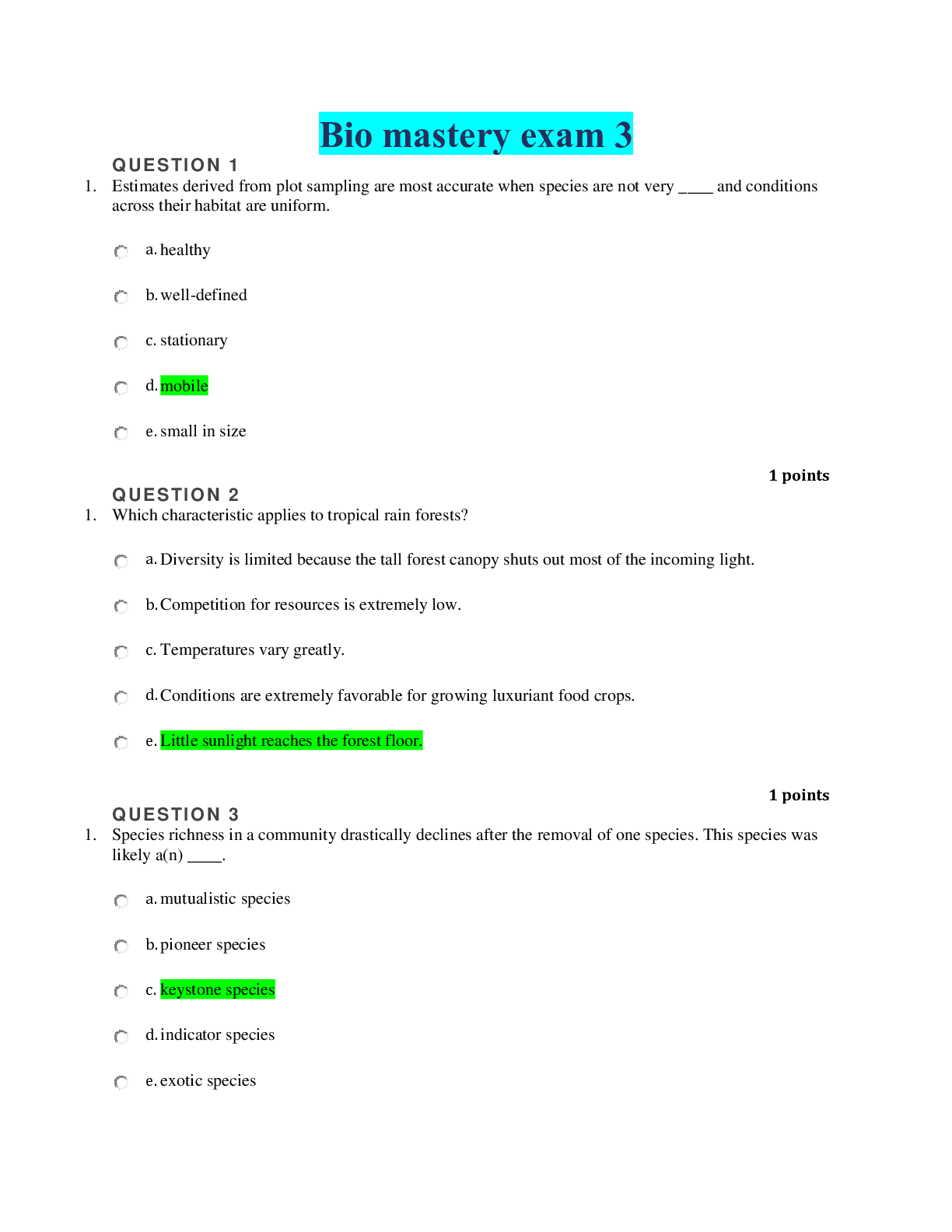
Buy this document to get the full access instantly
Instant Download Access after purchase
Add to cartInstant download
We Accept:

Reviews( 0 )
$20.00
Document information
Connected school, study & course
About the document
Uploaded On
Sep 25, 2020
Number of pages
25
Written in
Additional information
This document has been written for:
Uploaded
Sep 25, 2020
Downloads
0
Views
44

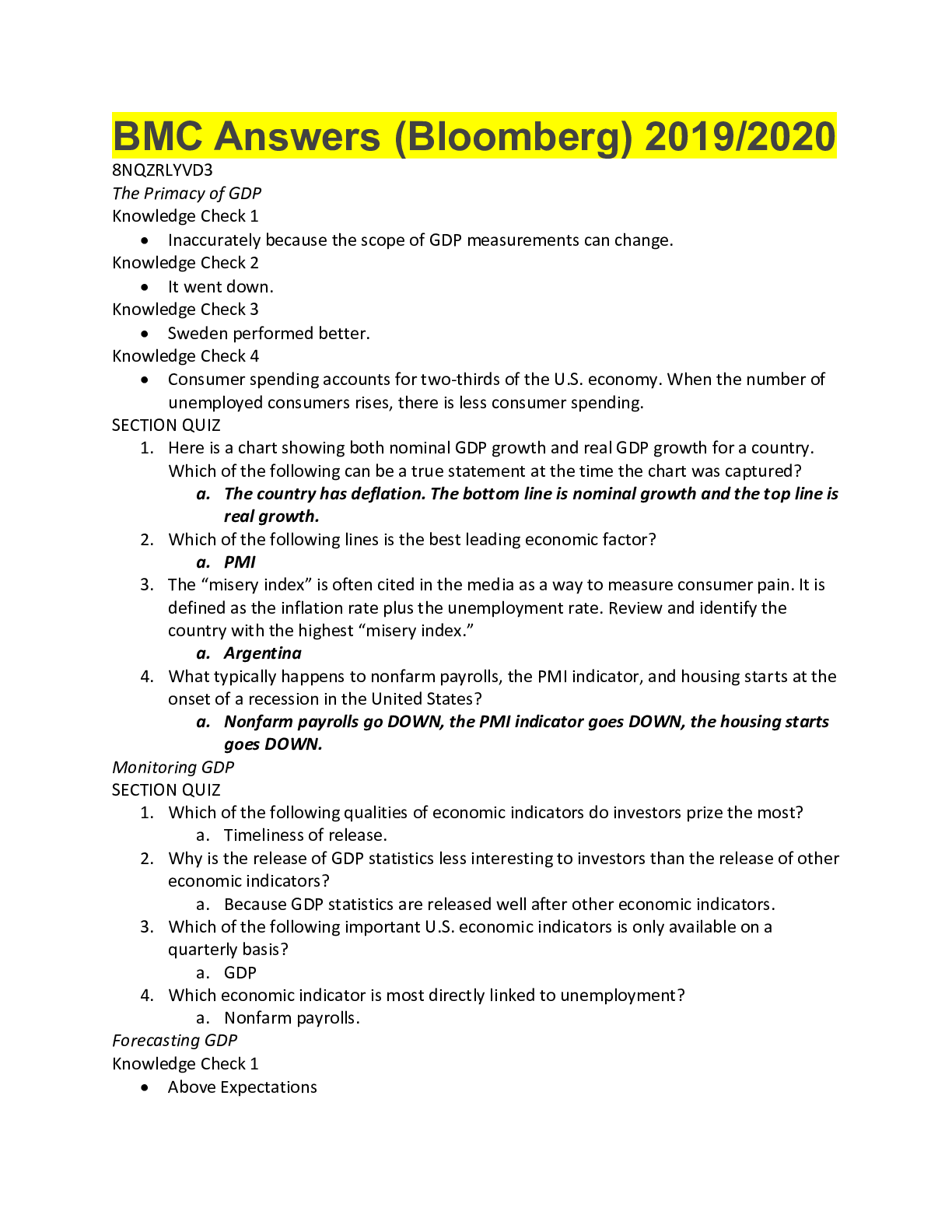
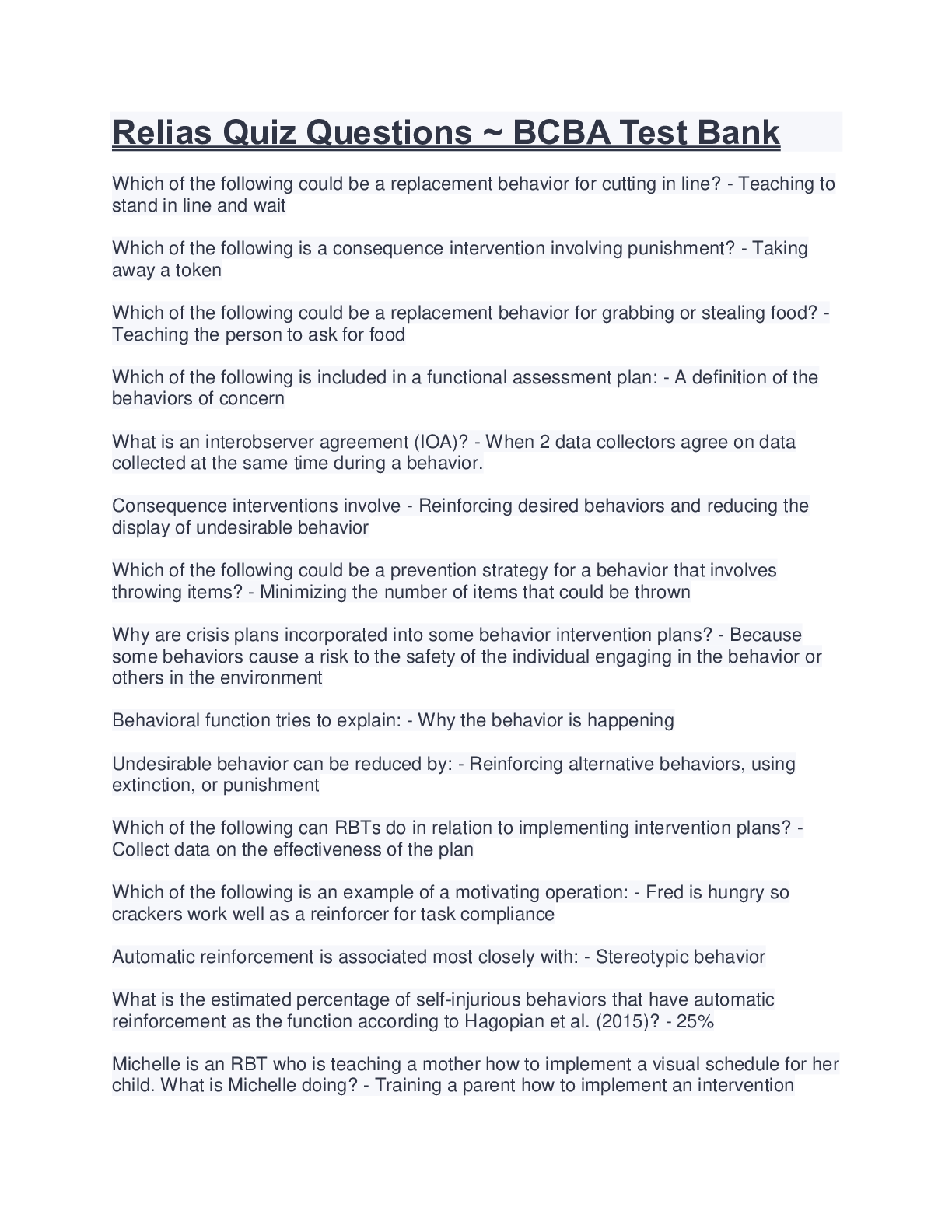
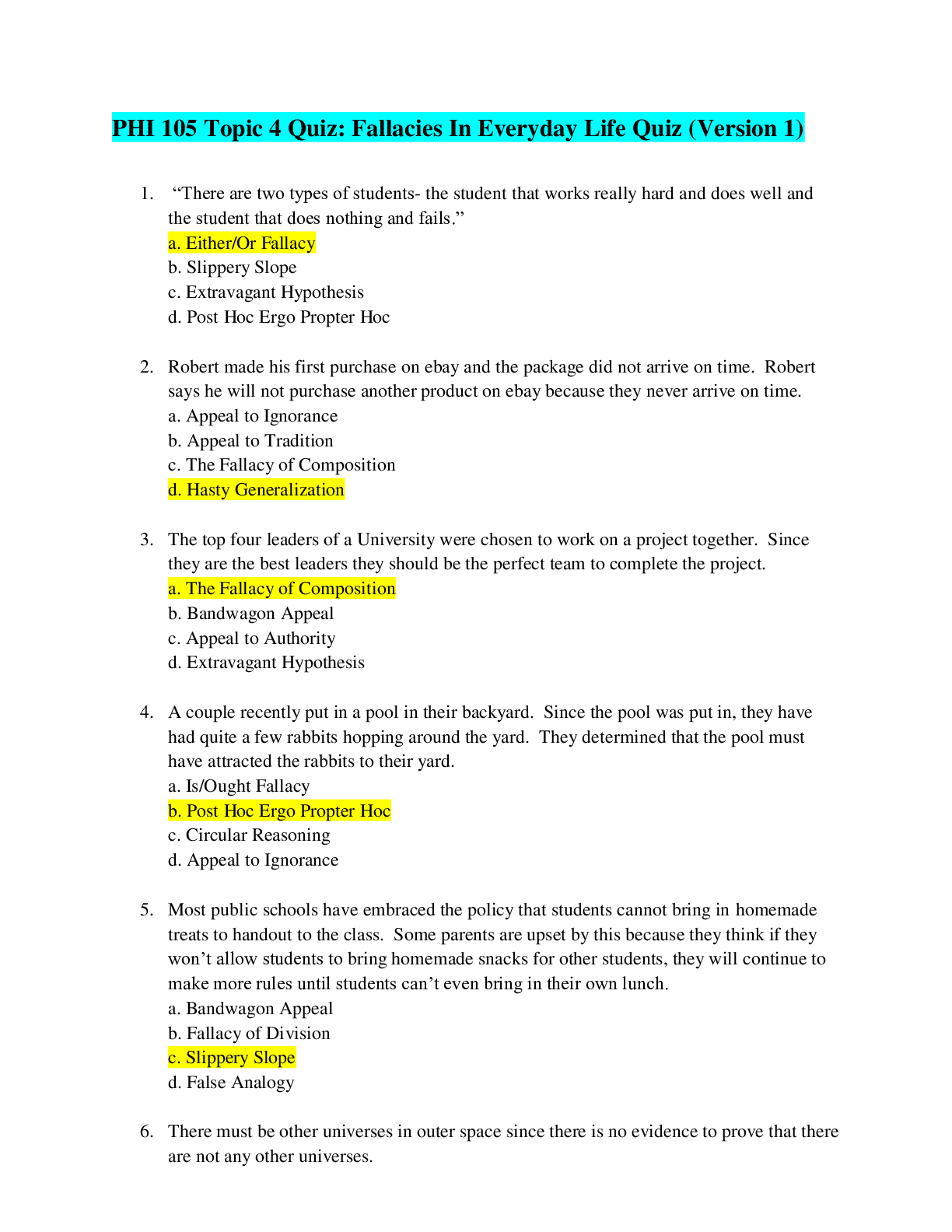


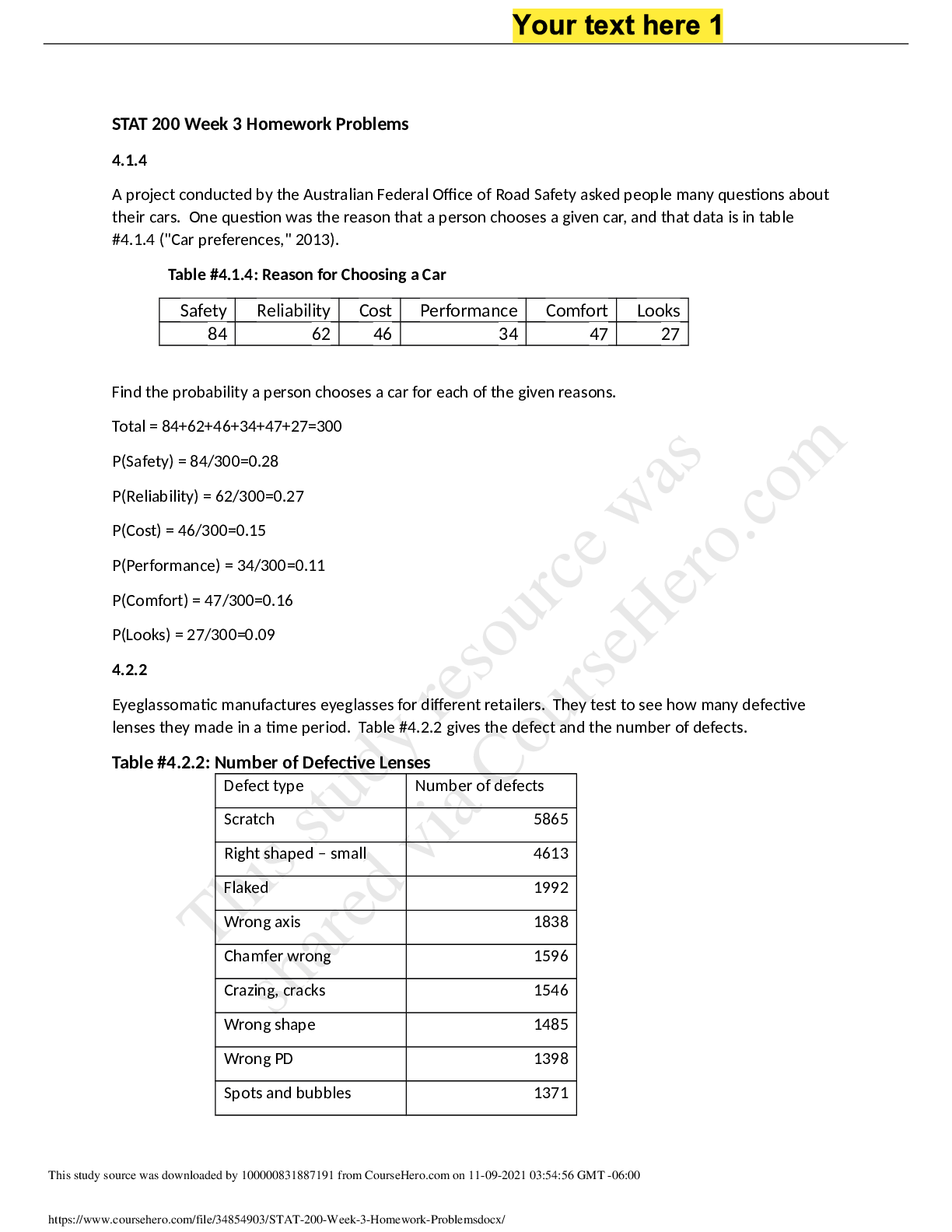

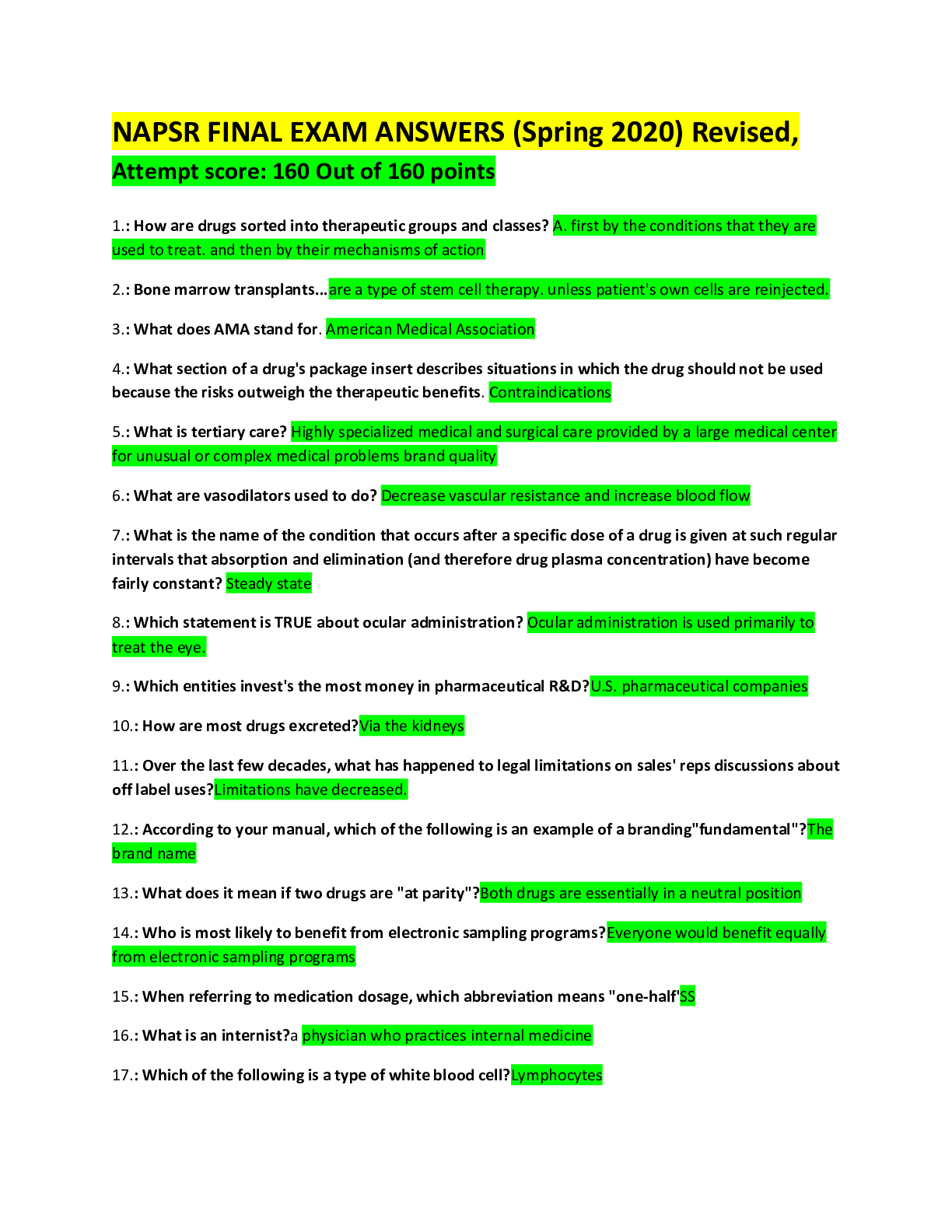

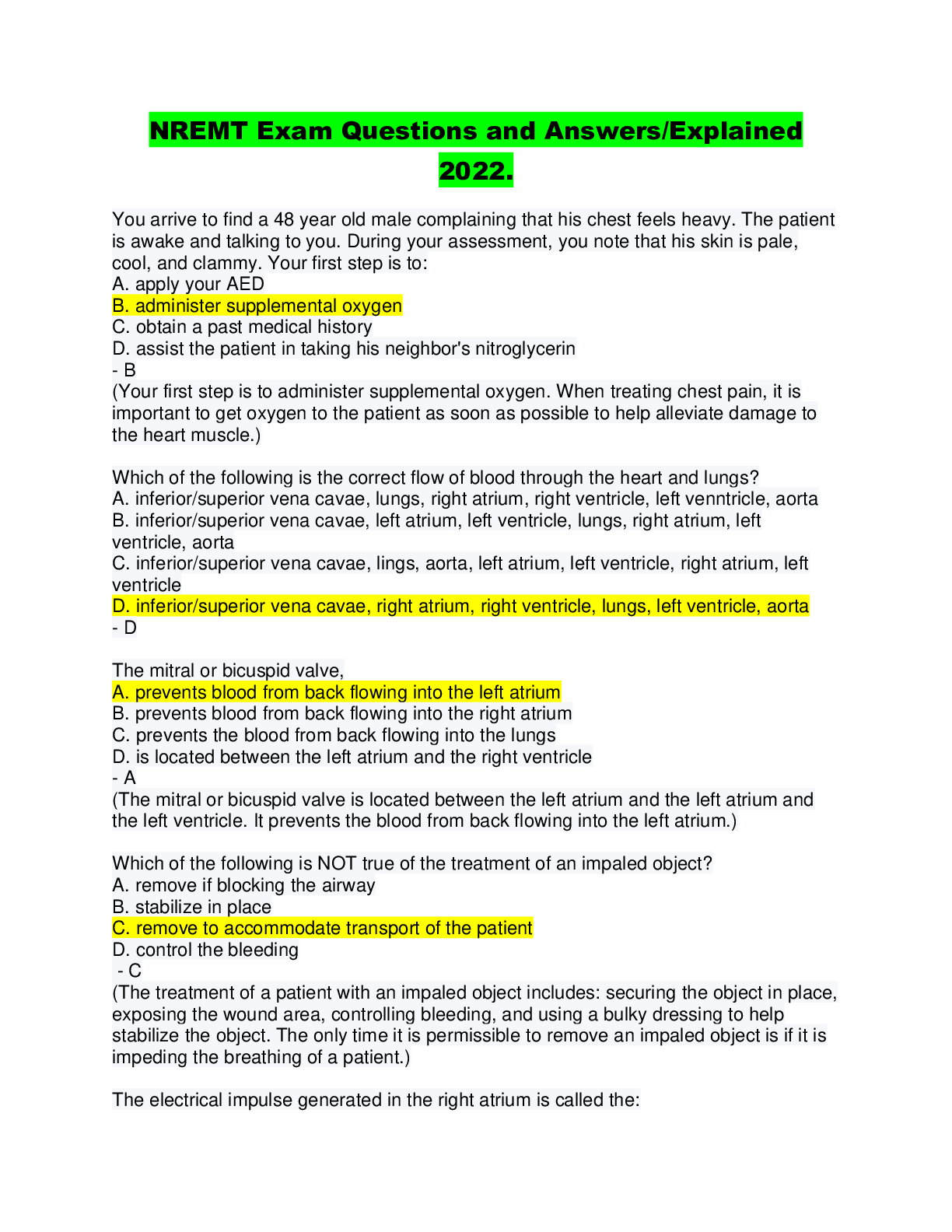
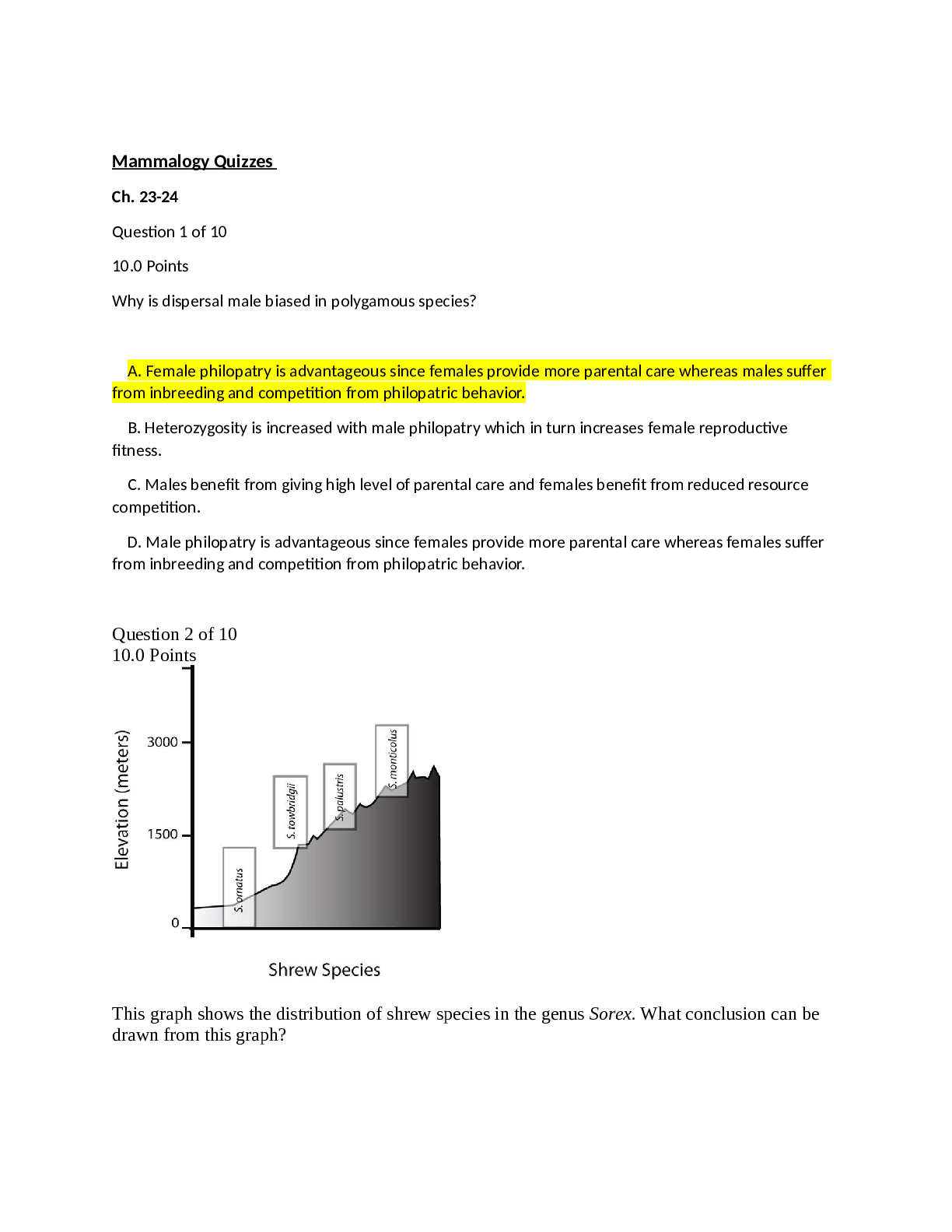
.png)
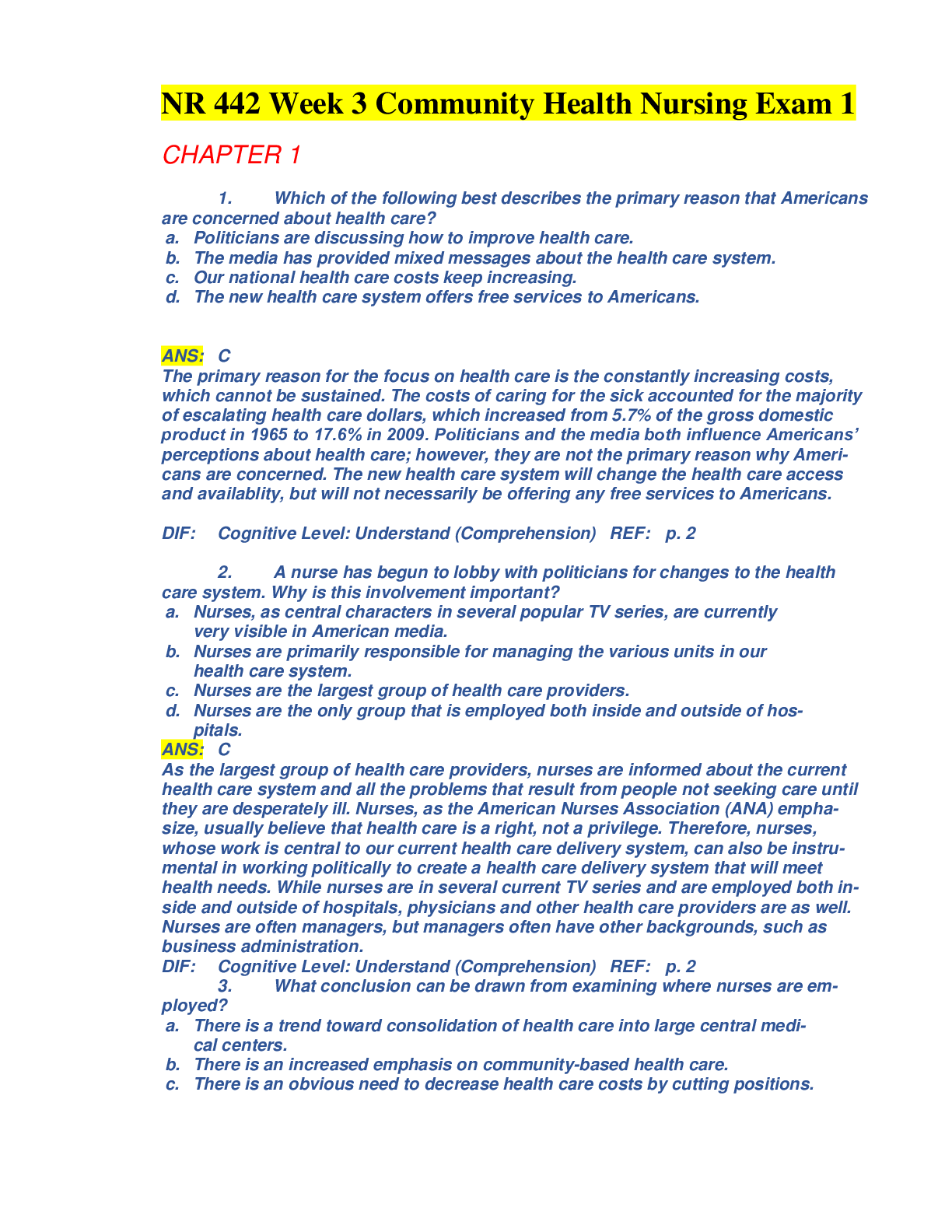
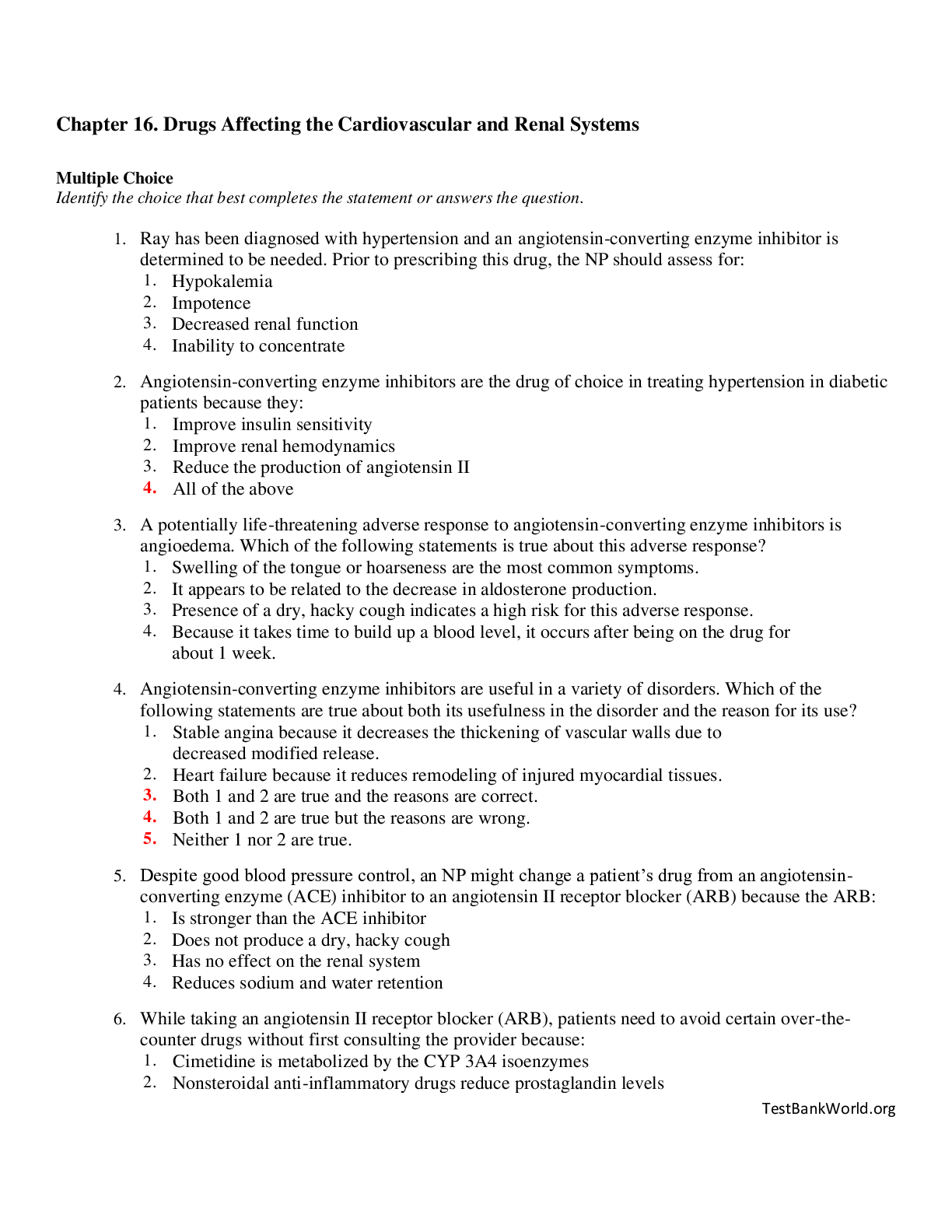

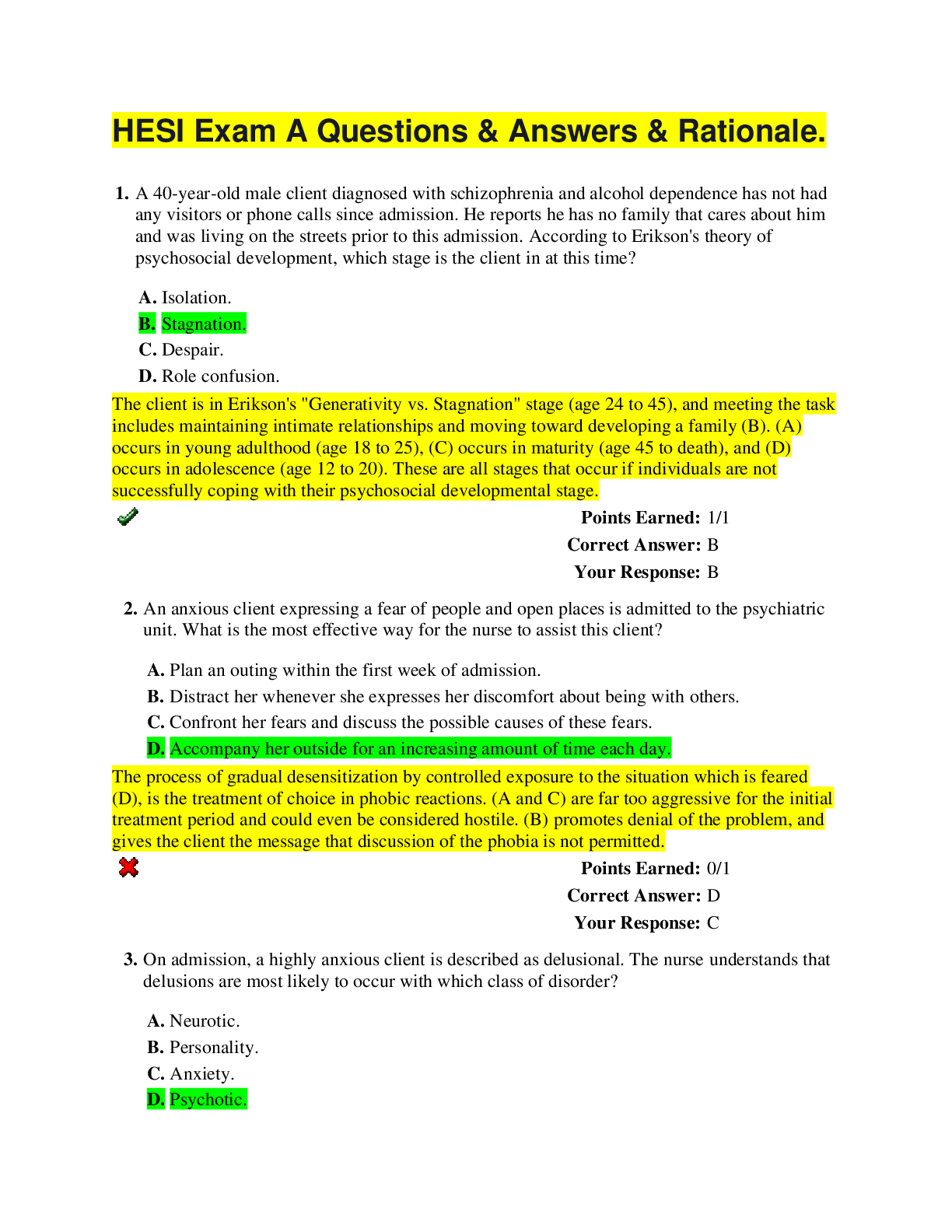
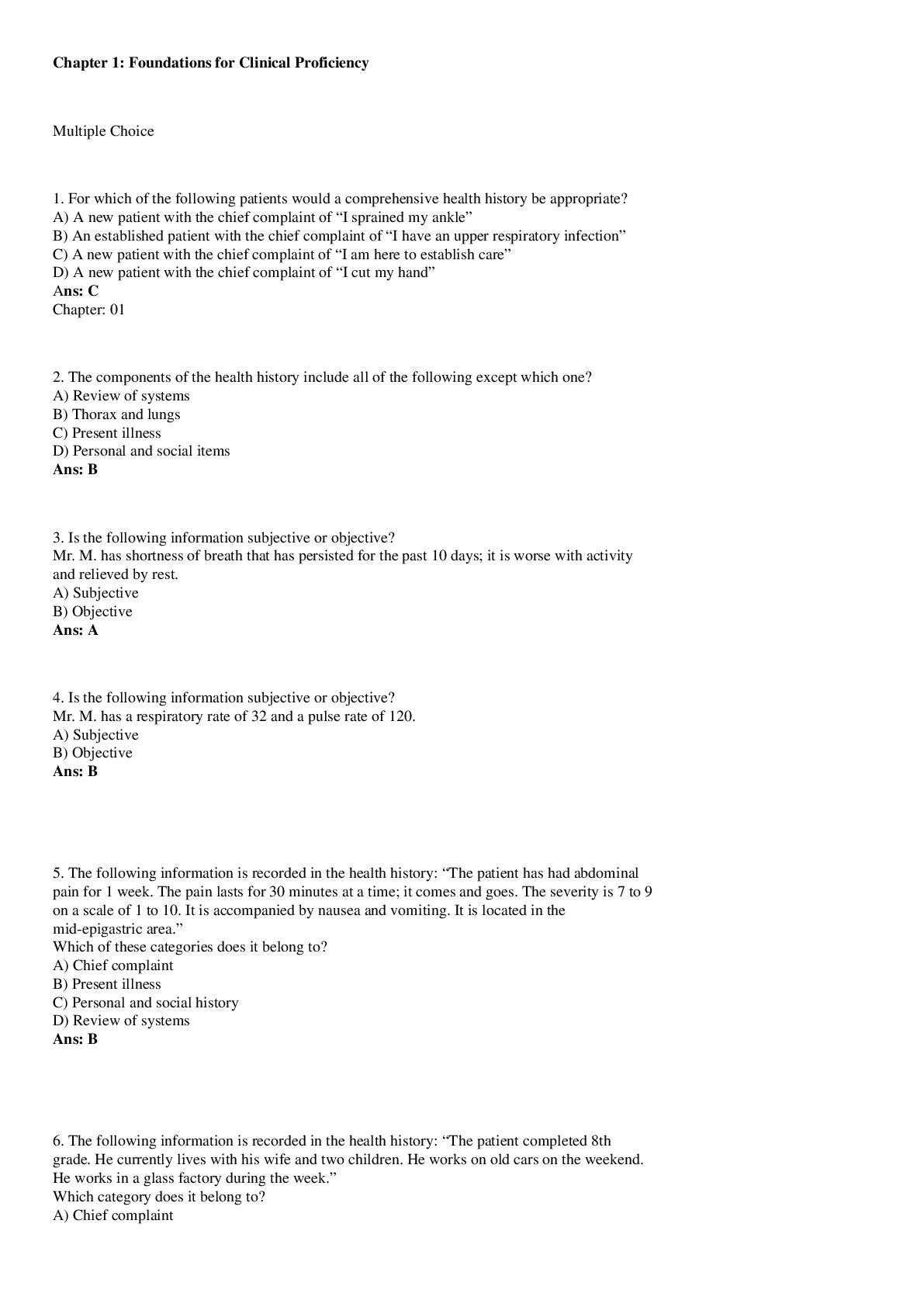
.png)


